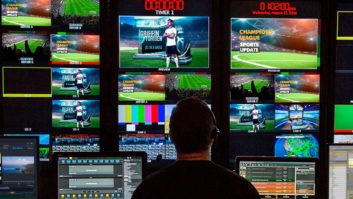
As loudness standards take effect in countries around the world, NUGEN Audio’s Jon Schorah (pictured), discusses the best approaches to loudness monitoring
Now that loudness standards are taking effect in countries around the world, broadcasters are settling into the new reality of having to monitor and manage audio loudness effectively, in addition to myriad other production tasks. Media enterprises are already grappling with loudness compliance and finding one of their biggest challenges is working out what loudness monitoring and measurement tools are most effective, and where and how to integrate these tools into the broadcast workflow. Here, we’ll outline some of the main considerations.
Metering approaches
There’s no doubt that clear, intuitive loudness metering is the key to delivering high-quality, loudness-compliant audio. But what are the options for loudness metering technology? In general, loudness recommendations are based on a loudness scale designed to correspond to the human ear, and effective metering tools can facilitate creativity in mixes, encouraging increased dynamic range and contrast. With a visual meter, editors can keep an eye on the meter and loudness profile while relying on their trained ears to make most of the decisions.
For post production, loudness metering software (plug-in or application) offers considerable advantages over standalone realtime hardware meters. Typically, the main target measure of integrated programme loudness requires that it be measured over the entire length of the programme. For example, making even a 30 second edit within a 50 minute documentary mandates that the entire 50 minutes be re-measured – something of a time issue when relying only on realtime meters. Many non-linear editors (eg Avid Pro Tools or Media Composer) allow for faster than realtime analysis; in addition, off-line file-based tools can speed up analysis considerably and save engineers large chunks of downtime while the measurements are acquired.
Another key consideration is the sample-peak limiter vs. true-peak limiter question. Unlike the more traditional sample-peak limiter approach, a true-peak limiter provides the true peak level, a measurement of the intersample peak that is a requirement in all of today’s loudness standards. Loudness normalisation deals with loudness jumps and consumer satisfaction issues, but peak levels still need to be measured to avoid distortion in the signal. Maximum peak measurement was specified in order to avoid noticeable clipping and distortion, however when using a sample-peak limiter, the real audio level may have gone above the maximum peak level in between samples. True Peak Level is designed to evaluate the peak within the original analogue signal with increased accuracy and avoid digital clipping.
Audio loudness measurement in practice
The subjective loudness of audio is where loudness measurements come into their own. For the first time, sound engineers have a set of metrics allowing them to respond to the audio in a similar way to the human ear, taking into account both frequency and duration. Today’s best loudness tools provide four key measurements: momentary, short-term, integrated programme loudness, and loudness range (LRA).
The most important measurement is integrated programme loudness, which is measured over the entire programme, or piece of audio. The typical target value as specified by EBU or ITU regulations is either -23 LUFS or -24 LKFS, depending on the regional requirement.
Requiring realtime loudness measurement of the entire programme could clearly be time-consuming, requiring the entire piece of audio to be played in before the meter can output a single value for programme loudness at the end of the programme. If you make an edit, you’ll need to measure the entire piece again to re-calculate the new value. In the days when only peak normalisation was necessary, this step would be skipped, as the only mandate was that the edited section was within peak limits. Now to achieve loudness compliance the entire spot has to be re-measured.
Loudness tools
To facilitate a rapid analysis of the entire audio section, some manufacturers provide offline loudness tools that can run the measurement using offline processing, many times faster than realtime, so the user doesn’t have to wait the length of the programme for a result. These tools are, in some cases, also able to make corrections to bring the loudness in on target at the press of a button; however, be sure these tools also utilise an integrated true-peak limiter in case the audio is normalised upwards.
In practice, since the new measurements are based on how our ears respond to sound, an experienced engineer in a calibrated room will usually mix naturally to +/-2 LU with an occasional glance at the meter just for guidance. Because sound engineers that are used to mixing within a healthy dynamic range are probably already mixing close to target, there is now more freedom to mix more openly and trust their ears more due to the increased headroom.
For those working in the advertising and music sectors, there is now an opportunity to move away from pushing into the limiter to achieve a louder result. The commercial imperatives that have previously driven broadcasters to maximise loudness according to their competition have been removed; in fact a heavily compressed mix will sound rather flat and dull compared to a dynamic mix normalised to the same loudness level. Viewers are the main beneficiaries, with programming and commercial content that has a more vibrant sound and lacks annoying loudness jumps.






